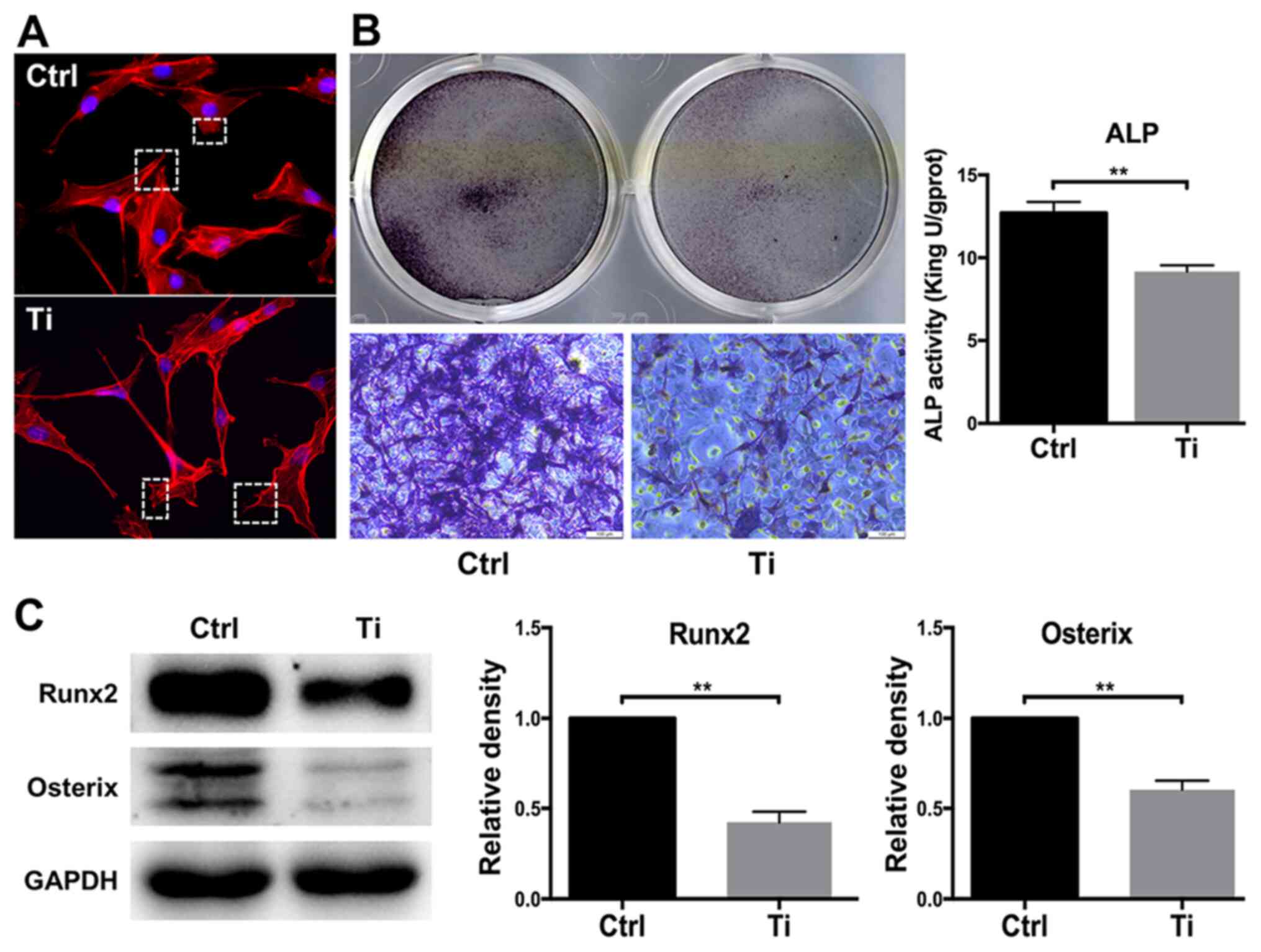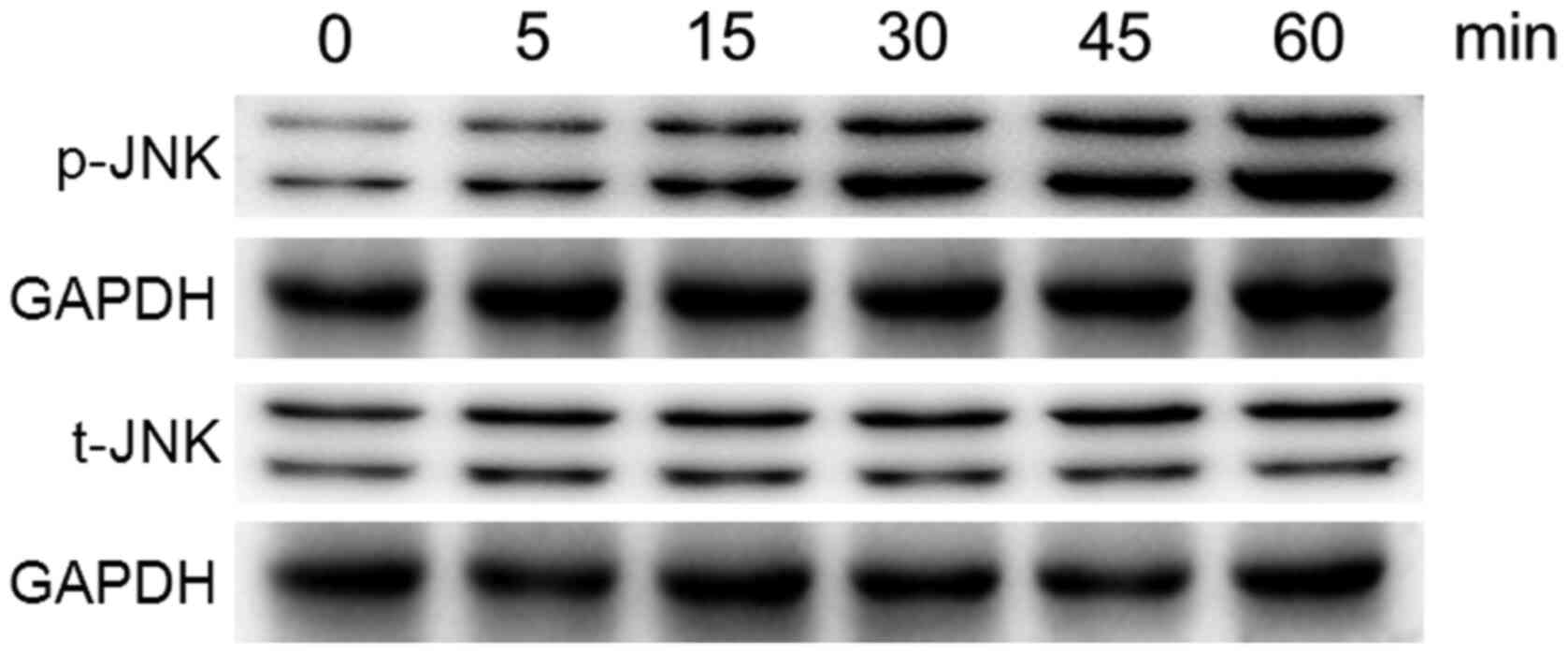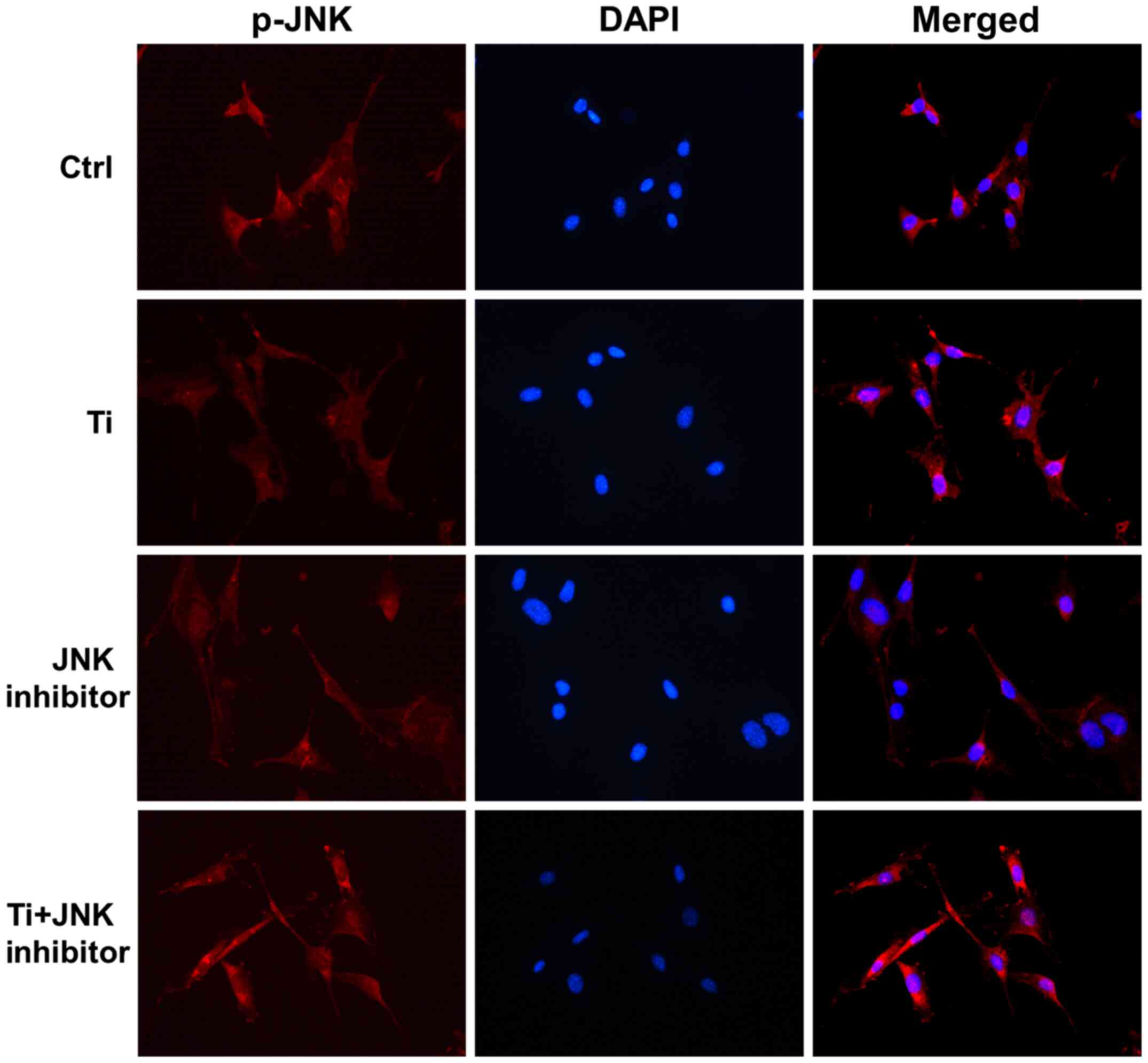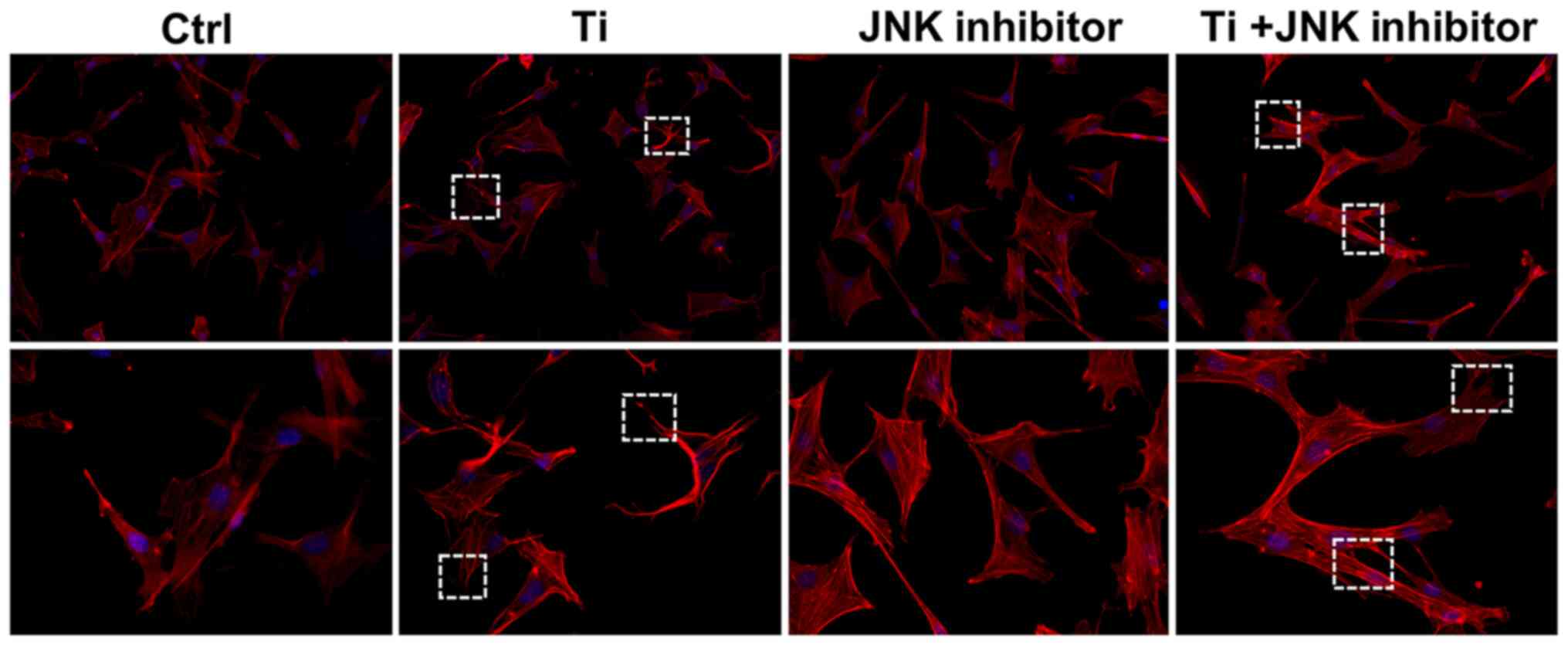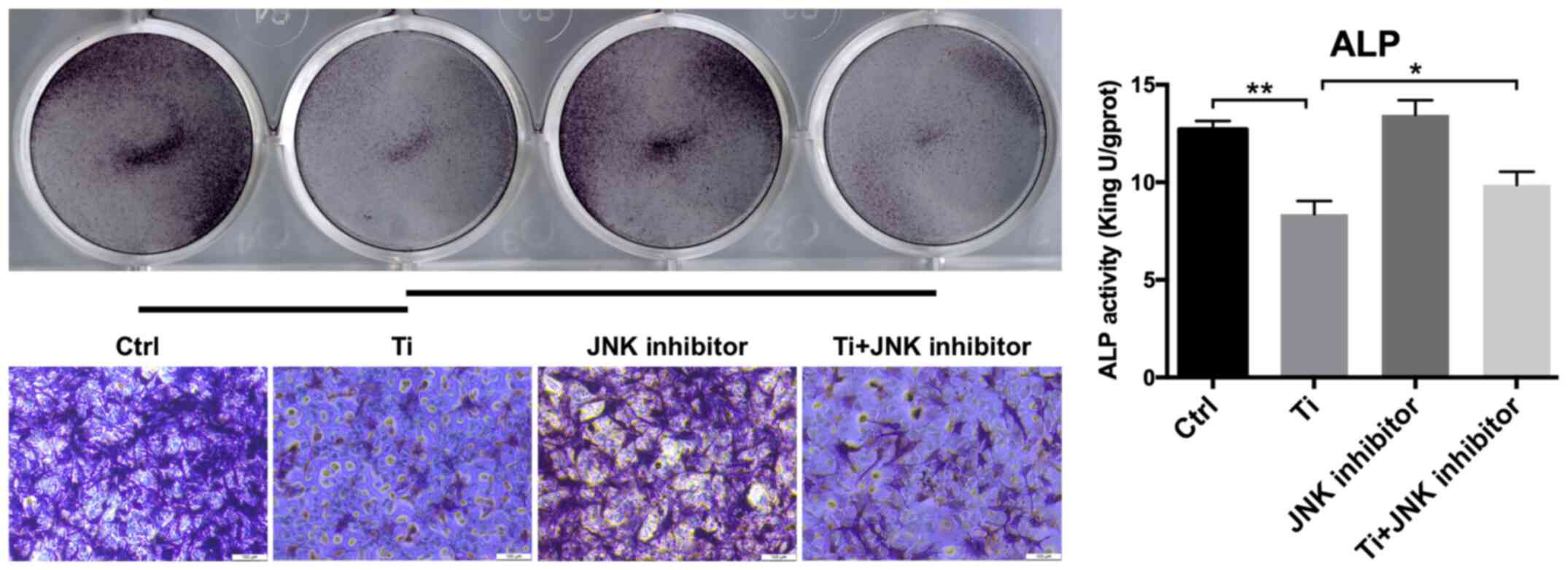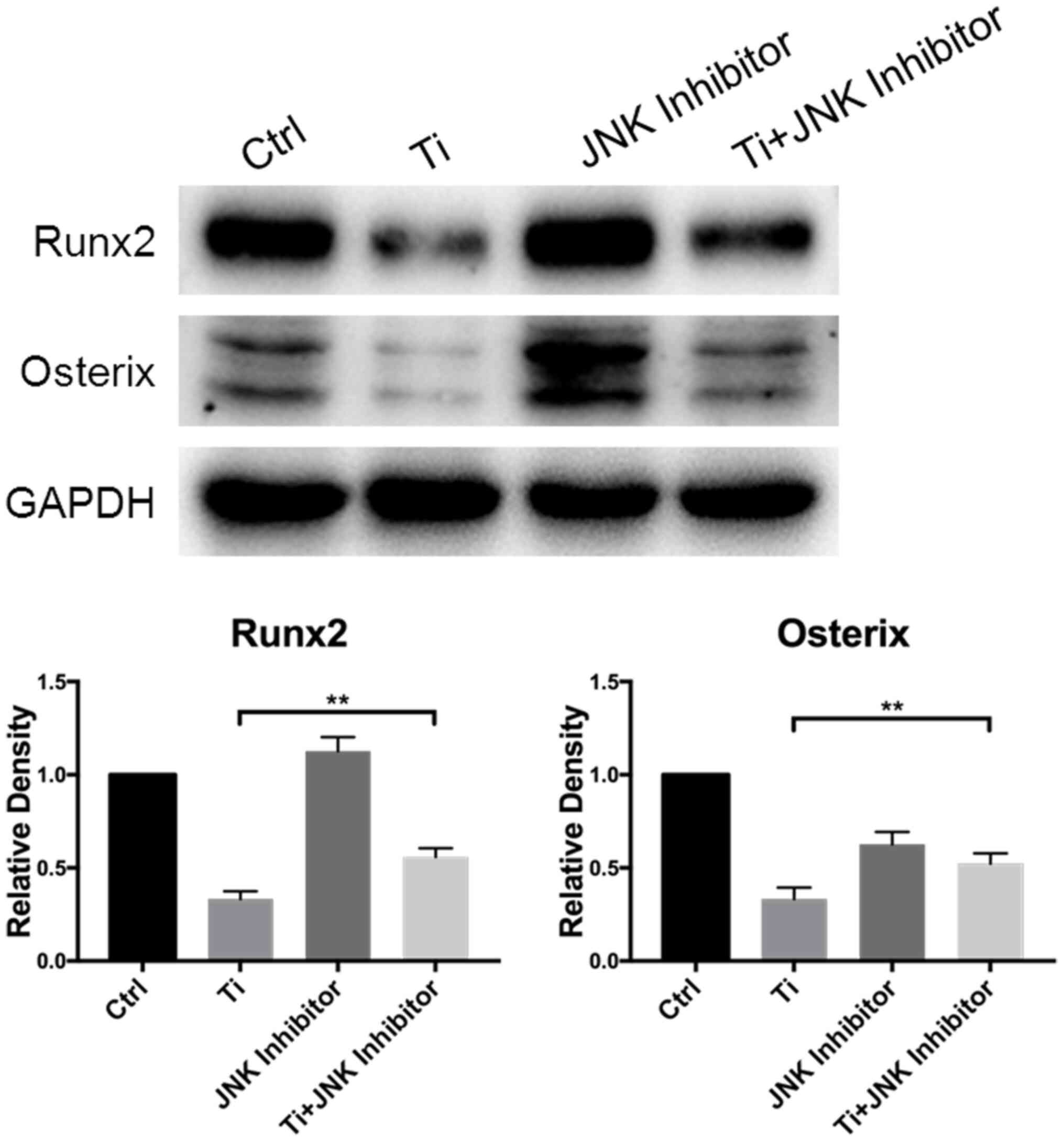|
1
|
Ahn TK, Lee DH, Kim TS, Jang GC, Choi S,
Oh JB, Ye G and Lee S: Modification of titanium implant and
titanium dioxide for bone tissue engineering. Adv Exp Med Biol.
1077:355–368. 2018. View Article : Google Scholar : PubMed/NCBI
|
|
2
|
Zhang X, Geng H, Gong L, Zhang Q, Li H,
Zhang X, Wang Y and Gao P: Modification of the surface of titanium
with multifunctional chimeric peptides to prevent biofilm formation
via inhibition of initial colonizers. Int J Nanomedicine.
13:5361–5375. 2018. View Article : Google Scholar : PubMed/NCBI
|
|
3
|
Zhu WQ, Shao SY, Xu LN, Chen WQ, Yu XY,
Tang KM, Tang ZH, Zhang FM and Qiu J: Enhanced corrosion resistance
of zinc-containing nanowires-modified titanium surface under
exposure to oxidizing microenvironment. J Nanobiotechnology.
17:552019. View Article : Google Scholar : PubMed/NCBI
|
|
4
|
Revathi A, Borrás AD, Muñoz AI, Richard C
and Manivasagam G: Degradation mechanisms and future challenges of
titanium and its alloys for dental implant applications in oral
environment. Mater Sci Eng C Mater Biol Appl. 76:1354–1368. 2017.
View Article : Google Scholar : PubMed/NCBI
|
|
5
|
Silva TSO, Freitas AR, Pinheiro MLL, do
Nascimento C, Watanabe E and Albuquerque RF: Oral biofilm formation
on different materials for dental implants. J Vis Exp.
24:577562018.
|
|
6
|
Puskar T, Jevremovic D, Williams RJ,
Eggbeer D, Vukelic D and Budak I: A comparative analysis of the
corrosive effect of artificial saliva of variable pH on DMLS and
Cast Co-Cr-Mo dental alloy. Materials (Basel). 7:6486–6501. 2014.
View Article : Google Scholar : PubMed/NCBI
|
|
7
|
Noronha Oliveira M, Schunemann WVH, Mathew
MT, Henriques B, Magini RS, Teughels W and Souza JCM: Can
degradation products released from dental implants affect
peri-implant tissues? J Periodontal Res. 53:1–11. 2017. View Article : Google Scholar : PubMed/NCBI
|
|
8
|
Golasik M, Herman M and Piekoszewski W:
Toxicological aspects of soluble titanium-a review of in vitro and
in vivo studies. Metallomics. 8:1227–1242. 2016. View Article : Google Scholar : PubMed/NCBI
|
|
9
|
Wachi T, Shuto T, Shinohara Y, Matono Y
and Makihira S: Release of titanium ions from an implant surface
and their effect on cytokine production related to alveolar bone
resorption. Toxicology. 327:1–9. 2015. View Article : Google Scholar : PubMed/NCBI
|
|
10
|
Wang Z, Deng Z, Gan J, Zhou G, Shi T, Wang
Z, Huang Z, Qian H, Bao N, Guo T, et al:
TiAl6V4 particles promote osteoclast
formation via autophagy-mediated downregulation of interferon-beta
in osteocytes. Acta Biomater. 48:489–498. 2017. View Article : Google Scholar : PubMed/NCBI
|
|
11
|
Stegen S, van Gastel N, Eelen G,
Ghesquière B, D'Anna F, Thienpont B, Goveia J, Torrekens S, Van
Looveren R, Luyten FP, et al: HIF-1α promotes glutamine-mediated
redox homeostasis and glycogen-dependent bioenergetics to support
postimplantation bone cell survival. Cell Metab. 23:265–279. 2016.
View Article : Google Scholar : PubMed/NCBI
|
|
12
|
Yu Y, Newman H, Shen L, Sharma D, Hu G,
Mirando AJ, Zhang H, Knudsen E, Zhang GF, Hilton MJ and Karner CM:
Glutamine metabolism regulates proliferation and lineage allocation
in skeletal stem cells. Cell Metab. 29:966–978.e4. 2019. View Article : Google Scholar : PubMed/NCBI
|
|
13
|
Fan Y, Hanai JI, Le PT, Bi R, Maridas D,
DeMambro V, Figueroa CA, Kir S, Zhou X, Mannstadt M, et al:
Parathyroid hormone directs bone marrow mesenchymal cell fate. Cell
Metab. 25:661–672. 2017. View Article : Google Scholar : PubMed/NCBI
|
|
14
|
Li JY, D'Amelio P, Robinson J, Walker LD,
Vaccaro C, Luo T, Tyagi AM, Yu M, Reott M, Sassi F, et al: IL-17A
is increased in humans with primary hyperparathyroidism and
mediates PTH-induced bone loss in mice. Cell Metab. 22:799–810.
2015. View Article : Google Scholar : PubMed/NCBI
|
|
15
|
Hayashi M, Nakashima T, Yoshimura N,
Okamoto K, Tanaka S and Takayanagi H: Autoregulation of osteocyte
Sema3A orchestrates estrogen action and counteracts bone aging.
Cell Metab. 29:627–637. 2019. View Article : Google Scholar : PubMed/NCBI
|
|
16
|
Miron RJ and Bosshardt DD: OsteoMacs: Key
players around bone biomaterials. Biomaterials. 82:1–19. 2016.
View Article : Google Scholar : PubMed/NCBI
|
|
17
|
Zhao S, Sun Y, Li X, Wang J, Yan L, Zhang
Z, Wang D, Dai J, He J and Wang S: Scutellarin inhibits
RANKL-mediated osteoclastogenesis and titanium particle-induced
osteolysis via suppression of NF-κB and MAPK signaling pathway. Int
Immunopharmacol. 40:458–465. 2016. View Article : Google Scholar : PubMed/NCBI
|
|
18
|
Berger JM, Singh P, Khrimian L, Morgan DA,
Chowdhury S, Arteaga-Solis E, Horvath TL, Domingos AI, Marsland AL,
Yadav VK, et al: Mediation of the acute stress response by the
skeleton. Cell Metab. 30:890–902 e8. 2019. View Article : Google Scholar : PubMed/NCBI
|
|
19
|
Lee H, Li C, Zhang Y, Zhang D, Otterbein
LE and Jin Y: Caveolin-1 selectively regulates microRNA sorting
into microvesicles after noxious stimuli. J Exp Med. 216:2202–2220.
2019. View Article : Google Scholar : PubMed/NCBI
|
|
20
|
Zhu WQ, Ming PP, Qiu J, Shao SY, Yu YJ,
Chen JX, Yang J, Xu LN, Zhang SM and Tang CB: Effect of titanium
ions on the Hippo/YAP signaling pathway in regulating biological
behaviors of MC3T3-E1 osteoblasts. J Appl Toxicol. 38:824–833.
2018. View
Article : Google Scholar : PubMed/NCBI
|
|
21
|
Chai S, Wan L, Wang JL, Huang JC and Huang
HX: Gushukang inhibits osteocyte apoptosis and enhances BMP-2/Smads
signaling pathway in ovariectomized rats. Phytomedicine.
64:1530632019. View Article : Google Scholar : PubMed/NCBI
|
|
22
|
Jimi E: The role of BMP signaling and
NF-κB signaling on osteoblastic differentiation, cancer
development, and vascular diseases-is the activation of NF-κB a
friend or foe of BMP function? Vitam Horm. 99:145–170. 2015.
View Article : Google Scholar : PubMed/NCBI
|
|
23
|
Lerner UH and Ohlsson C: The WNT system:
Background and its role in bone. J Intern Med. 277:630–649. 2015.
View Article : Google Scholar : PubMed/NCBI
|
|
24
|
Xu C, Wang J, Zhu T, Shen Y, Tang X, Fang
L and Xu Y: Cross-talking between PPAR and WNT signaling and its
regulation in mesenchymal stem cell differentiation. Curr Stem Cell
Res Ther. 11:247–254. 2016. View Article : Google Scholar : PubMed/NCBI
|
|
25
|
Jia L, Zhang Y, Ji Y, Xiong Y, Zhang W,
Wen Y and Xu X: YAP balances the osteogenic and adipogenic
differentiation of hPDLSCs in vitro partly through the
Wnt/β-catenin signaling pathway. Biochem Biophys Res Commun.
518:154–160. 2019. View Article : Google Scholar : PubMed/NCBI
|
|
26
|
Zhu WQ, Yu YJ, Xu LN, Ming PP, Shao SY and
Qiu J: Regulation of osteoblast behaviors via cross-talk between
Hippo/YAP and MAPK signaling pathway under fluoride exposure. J Mol
Med (Berl). 97:1003–1017. 2019. View Article : Google Scholar : PubMed/NCBI
|
|
27
|
Zheng W, Gu X, Hu D and Hao Y: Co-culture
with synovial tissue in patients with rheumatoid arthritis suppress
cell proliferation by regulating MAPK pathway in osteoblasts. Am J
Transl Res. 11:3317–3327. 2019.PubMed/NCBI
|
|
28
|
Chen J, Cao J and Luo Y: Expression of ERK
and p-ERK proteins of ERK signaling pathway in the kidneys of
fluoride-exposed carp (Cyprinus carpio). Acta Histochem.
116:1337–1341. 2014. View Article : Google Scholar : PubMed/NCBI
|
|
29
|
Huang D, Li X, Sun L, Huang P, Ying H,
Wang H, Wu J and Song H: Regulation of Hippo signalling by p38
signalling. J Mol Cell Biol. 8:328–337. 2016. View Article : Google Scholar : PubMed/NCBI
|
|
30
|
Cao Chen J, Xie L, Wang J, Feng C and Song
J: Protective properties of sesamin against fluoride-induced
oxidative stress and apoptosis in kidney of carp (Cyprinus
carpio) via JNK signaling pathway. Aquat Toxicol. 167:180–190.
2015. View Article : Google Scholar : PubMed/NCBI
|
|
31
|
Mizerska-Kowalska M, Slawinska-Brych A,
Kalawaj K, Żurek A, Pawińska B, Rzeski W and Zdzisińska B: Betulin
promotes differentiation of human osteoblasts in vitro and exerts
an osteoinductive effect on the hFOB 1.19 cell line through
activation of JNK, ERK1/2, and mTOR kinases. Molecules.
24:2637–2653. 2019. View Article : Google Scholar
|
|
32
|
Balera Brito VG, Chaves-Neto AH, Landim de
Barros T and Penha Oliveira SH: Soluble yerba mate (Ilex
Paraguariensis) extract enhances in vitro osteoblastic
differentiation of bone marrow-derived mesenchymal stromal cells. J
Ethnopharmacol. 244:1121312019. View Article : Google Scholar : PubMed/NCBI
|
|
33
|
Kawabata T, Tokuda H, Fujita K,
Matsushima-Nishiwaki R, Sakai G, Tachi J, Hioki T, Kim W, Iida H,
Otsuka T and Kozawa O: HSP90 inhibitors diminish PDGF-BB-induced
migration of osteoblasts via suppression of p44/p42 MAP kinase.
Biomed Res. 40:169–178. 2019. View Article : Google Scholar : PubMed/NCBI
|
|
34
|
Hayes JS, Khan IM, Archer CW and Richards
RG: The role of surface microtopography in the modulation of
osteoblast differentiation. Eur Cell Mater. 20:98–108. 2010.
View Article : Google Scholar : PubMed/NCBI
|
|
35
|
Glynn ER, Londono AS, Zinn SA, Hoagland TA
and Govoni KE: Culture conditions for equine bone marrow
mesenchymal stem cells and expression of key transcription factors
during their differentiation into osteoblasts. J Anim Sci
Biotechnol. 4:402013. View Article : Google Scholar : PubMed/NCBI
|
|
36
|
Komori T: Regulation of osteoblast
differentiation by transcription factors. J Cell Biochem.
99:1233–1239. 2006. View Article : Google Scholar : PubMed/NCBI
|
|
37
|
Ting M, Craig J, Balkin BE and Suzuki JB:
Peri-implantitis: A Comprehensive overview of systematic reviews. J
Oral Implantol. 44:225–247. 2018. View Article : Google Scholar : PubMed/NCBI
|
|
38
|
Romanos GE, Delgado-Ruiz R and Sculean A:
Concepts for prevention of complications in implant therapy.
Periodontol 2000. 81:7–17. 2019. View Article : Google Scholar : PubMed/NCBI
|
|
39
|
Di Laura A, Hothi HS, Meswania JM,
Whittaker RK, de Villiers D, Zustin J, Blunn GW, Skinner JA and
Hart AJ: Clinical relevance of corrosion patterns attributed to
inflammatory cell-induced corrosion: A retrieval study. J Biomed
Mater Res B Appl Biomater. 105:155–164. 2017. View Article : Google Scholar : PubMed/NCBI
|
|
40
|
Yu WQ, Qiu J and Zhang FQ: In vitro
corrosion study of different TiO2 nanotube layers on titanium in
solution with serum proteins. Colloids Surf B Biointerfaces.
84:400–405. 2011. View Article : Google Scholar : PubMed/NCBI
|
|
41
|
Noumbissi S, Scarano A and Gupta S: A
literature review study on atomic ions dissolution of titanium and
its alloys in implant dentistry. Materials (Basel). 12:3682019.
View Article : Google Scholar
|
|
42
|
Mercan S, Bölükbaşı N, Bölükbaşı MK, Yayla
M and Cengiz S: Titanium element level in peri-implant mucosa.
Biotechnol Biotechnol Equip. 27:4002–4005. 2014. View Article : Google Scholar
|
|
43
|
Messer RL, Tackas G, Mickalonis J, Brown
Y, Lewis JB and Wataha JC: Corrosion of machined titanium dental
implants under inflammatory conditions. J Biomed Mater Res B Appl
Biomater. 88:474–481. 2009. View Article : Google Scholar : PubMed/NCBI
|
|
44
|
Vallés G, González-Melendi P,
González-Carrasco JL, Saldaña L, Sánchez-Sabaté E, Munuera L and
Vilaboa N: Differential inflammatory macrophage response to rutile
and titanium particles. Biomaterials. 27:5199–5211. 2006.
View Article : Google Scholar : PubMed/NCBI
|
|
45
|
Costa V, Carina V, Fontana S, De Luca A,
Monteleone F, Pagani S, Sartori M, Setti S, Faldini C, Alessandro
R, et al: Osteogenic commitment and differentiation of human
mesenchymal stem cells by low-intensity pulsed ultrasound
stimulation. J Cell Physiol. 233:1558–1573. 2018. View Article : Google Scholar : PubMed/NCBI
|
|
46
|
Zou W, Greenblatt MB, Brady N, Lotinun S,
Zhai B, de Rivera H, Singh A, Sun J, Gygi SP, Baron R, et al: The
microtubule-associated protein DCAMKL1 regulates osteoblast
function via repression of Runx2. J Exp Med. 210:1793–1806. 2013.
View Article : Google Scholar : PubMed/NCBI
|
|
47
|
Maehata Y, Takamizawa S, Ozawa S, Kato Y,
Sato S, Kubota E and Hata R: Both direct and collagen-mediated
signals are required for active vitamin D3-elicited differentiation
of human osteoblastic cells: Roles of osterix, an
osteoblast-related transcription factor. Matrix Biol. 25:47–58.
2006. View Article : Google Scholar : PubMed/NCBI
|
|
48
|
Zhou W, Zhang J, Lin K and Chen F:
Comparison between mandibular and femur derived bone marrow stromal
cells: Osteogenic and angiogenic potentials in vitro and bone
repairing ability in vivo. RSC Adv. 7:56220–56228. 2017. View Article : Google Scholar
|
|
49
|
Zhang DD, Wu YF, Chen WX, Xu Y, Liu SY,
Luo HH, Jiang GM, Wu Y and Hu P: C-type natriuretic peptide
attenuates renal osteodystrophy through inhibition of FGF-23/MAPK
signaling. Exp Mol Med. 51:702019. View Article : Google Scholar : PubMed/NCBI
|
|
50
|
Chen M, Chen PM, Dong QR, Huang Q, She C
and Xu W: p38 Signaling in titanium particle-induced MMP-2
secretion and activation in differentiating MC3T3-E1 cells. J
Biomed Mater Res A. 102:2824–2832. 2014. View Article : Google Scholar : PubMed/NCBI
|
|
51
|
Li K, Yang F, Zhang G, Song S, Li Y, Ren
D, Miao Y and Song CP: AIK1, a mitogen-activated protein kinase,
modulates abscisic acid responses through the MKK5-MPK6 kinase
cascade. Plant Physiol. 173:1391–1408. 2017. View Article : Google Scholar : PubMed/NCBI
|
|
52
|
Wang C, Sun H and Zhong Y: Notoginsenoside
R1 promotes MC3T3-E1 differentiation by up-regulating miR-23a via
MAPK and JAK1/STAT3 pathways. Artif Cells Nanomed Biotechnol.
47:603–609. 2019.PubMed/NCBI
|
|
53
|
Ewendt F and Föller M: p38MAPK controls
fibroblast growth factor 23 (FGF23) synthesis in
UMR106-osteoblast-like cells and in IDG-SW3 osteocytes. J
Endocrinol Invest. 42:1477–1483. 2019. View Article : Google Scholar : PubMed/NCBI
|
|
54
|
Liu S, Parameswaran H, Young SM and
Varisco BM: JNK suppresses pulmonary fibroblast elastogenesis
during alveolar development. Respir Res. 15:342014. View Article : Google Scholar : PubMed/NCBI
|
|
55
|
Fleming Y, Armstrong CG, Morrice N,
Paterson A, Goedert M and Cohen P: Synergistic activation of
stress-activated protein kinase 1/c-Jun N-terminal kinase
(SAPK1/JNK) isoforms by mitogen-activated protein kinase kinase 4
(MKK4) and MKK7. Biochem J. 145–154. 2000. View Article : Google Scholar : PubMed/NCBI
|
|
56
|
Chen K, Ng PY, Chen R, Hu D, Berry S,
Baron R and Gori F: Sfrp4 repression of the Ror2/Jnk cascade in
osteoclasts protects cortical bone from excessive endosteal
resorption. Proc Natl Acad Sci USA. 116:14138–14143. 2019.
View Article : Google Scholar : PubMed/NCBI
|
|
57
|
Ouyang Z, Huang Q, Liu B, Wu H, Liu T and
Liu Y: Rubidium chloride targets Jnk/p38-mediated NF-κB activation
to attenuate osteoclastogenesis and facilitate osteoblastogenesis.
Front Pharmacol. 10:5842019. View Article : Google Scholar : PubMed/NCBI
|
|
58
|
Gao P, Wang H, Liu J, Wu Y, Hei W, He Z,
Cai C, Guo X, Cao G and Li B: miR-128 regulated the proliferation
and autophagy in porcine adipose-derived stem cells through
targeting the JNK signaling pathway. J Recept Signal Transduct Res.
1–6. 2020.(Online ahead of print). View Article : Google Scholar
|
|
59
|
Mulder SE, Dasgupta A, King RJ, Abrego J,
Attri KS, Murthy D, Shukla SK and Singh PK: JNK signaling
contributes to skeletal muscle wasting and protein turnover in
pancreatic cancer cachexia. Cancer Lett. 491:70–77. 2020.(Online
ahead of print). View Article : Google Scholar : PubMed/NCBI
|















